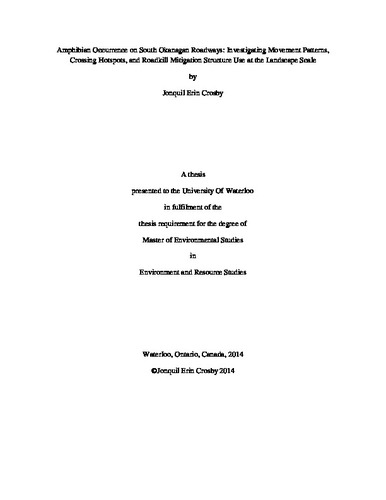| dc.contributor.author | Crosby, Jonquil | |
| dc.date.accessioned | 2014-06-19 12:39:21 (GMT) | |
| dc.date.available | 2014-06-19 12:39:21 (GMT) | |
| dc.date.issued | 2014-06-19 | |
| dc.date.submitted | 2014 | |
| dc.identifier.uri | http://hdl.handle.net/10012/8538 | |
| dc.description.abstract | Road expansion and increased traffic likely exacerbates barriers to amphibian migration and dispersal. Within British Columbia’s south Okanagan valley there is particular concern that the COSEWIC-listed blotched tiger salamander (Ambystoma mavortium melanostictum) and Great Basin spadefoot (Spea intermontana) are vulnerable to road effects in their annual movements from upland overwintering habitat to lowland breeding areas. My study utilizes a before after control impact approach to assess amphibian movement and population threats across this highway-bisected landscape. Throughout the spring and summer of 2010-2012, fifty two kilometers of roadways (31 km of highway, 21 km of paved backroad) were repeatedly surveyed from the Canada-USA border to north of Oliver, BC; surveys were carried out utilising vehicles and on foot. Along Highway 97, a three kilometer four-lane highway expansion project was constructed through 2010 and open to traffic use in 2011. Adjacent to a floodplain, survey effort was focused throughout this transect for informed roadkill mitigation structure placement and ongoing ecopassage effectiveness monitoring. Automated camera trap monitoring of culverts within highly concentrated amphibian road hotspots during spring and summer 2011 (three culverts) and 2012 (two culverts) resulted in over eight hundred amphibian culvert events observed. Two sample Wilcoxon tests revealed differences between years in amphibian occurrence between 2010 and 2012 (W = 4679.5, p= 0.02), and mortalities among transect areas, with the largest differences between years within the Osoyoos passing lanes transect. Amphibian mortalities within the passing lanes transect were significantly reduced with the implementation of mitigation structures (x̅2010= 13.2 ± 32.5, x̅2011= 4.7 ± 12.8, x̅2012= 2.3 ± 7.3; 2010 vs. 2012: W= 1535.5, p< 0.001). Roadkill mitigation structures proved effective in observed amphibian occurrence of the entire passing lanes stretch as well as at distances 100 m and 200 m from observed culverts. Double fenced areas resulted in a 94% reduction in amphibian road occurrence. Five species of amphibians were observed over the three survey years (4051 road incidences over 657 survey hours): Pacific chorus frog (Pseudacris regilla), Western toad (Anaxyrus boreas), long-toed salamander (Ambystoma macrodactylum) plus blotched tiger salamander and Great Basin spadefoot. This study aims to provide a better understanding of amphibian hotspots on roadways and ecopassage use within the south Okanagan. It may act as a catalyst to further wildlife-vehicle interaction studies with improved mitigation solutions for amphibian roadway fatalities. | en |
| dc.language.iso | en | en |
| dc.publisher | University of Waterloo | en |
| dc.subject | road ecology | en |
| dc.subject | wildlife-vehicle collisions | en |
| dc.subject | roadkill | en |
| dc.subject | amphibian | en |
| dc.subject | Great Basin spadefoot | en |
| dc.subject | Spea intermontana | en |
| dc.subject | south Okanagan | en |
| dc.subject | camera trap | en |
| dc.title | Amphibian Occurrence on South Okanagan Roadways: Investigating Movement Patterns, Crossing Hotspots, and Roadkill Mitigation Structure Use at the Landscape Scale | en |
| dc.type | Master Thesis | en |
| dc.pending | false | |
| dc.subject.program | Environmental and Resource Studies | en |
| uws-etd.degree.department | Environment and Resource Studies | en |
| uws-etd.degree | Master of Environmental Studies | en |
| uws.typeOfResource | Text | en |
| uws.peerReviewStatus | Unreviewed | en |
| uws.scholarLevel | Graduate | en |

